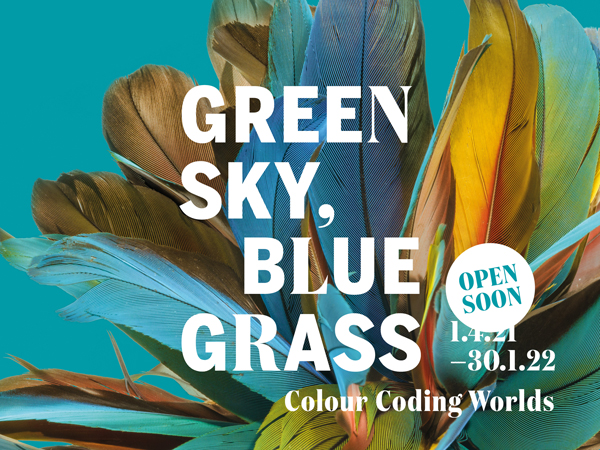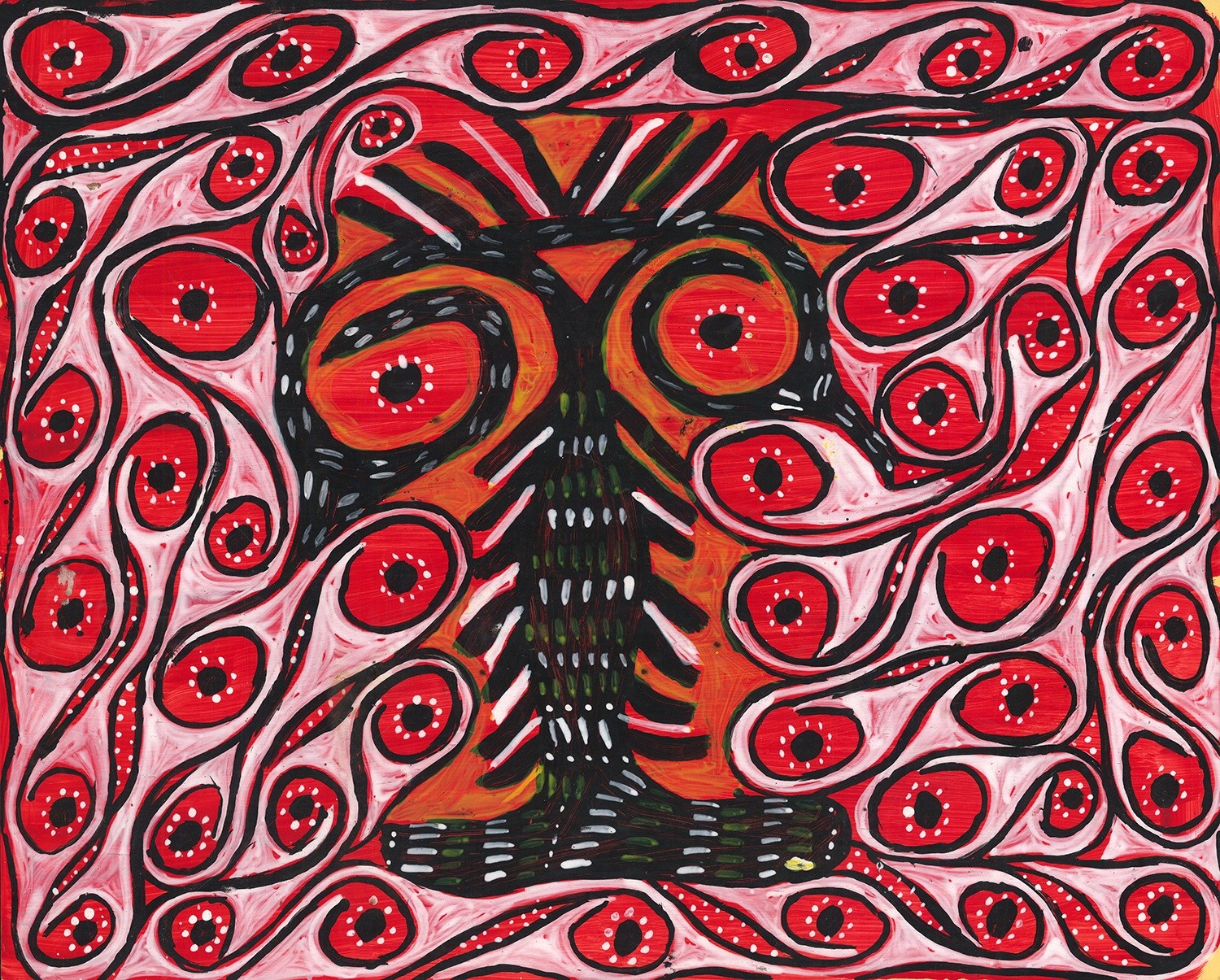 Sebastian Katuk, 2019: Kinin Kumnya. Acrylic on paper. Avim, Upper Karawari, New Guinea. Collected by Tomi Bartole, 2019. Collection Weltkulturen Museum
Sebastian Katuk, 2019: Kinin Kumnya. Acrylic on paper. Avim, Upper Karawari, New Guinea. Collected by Tomi Bartole, 2019. Collection Weltkulturen Museum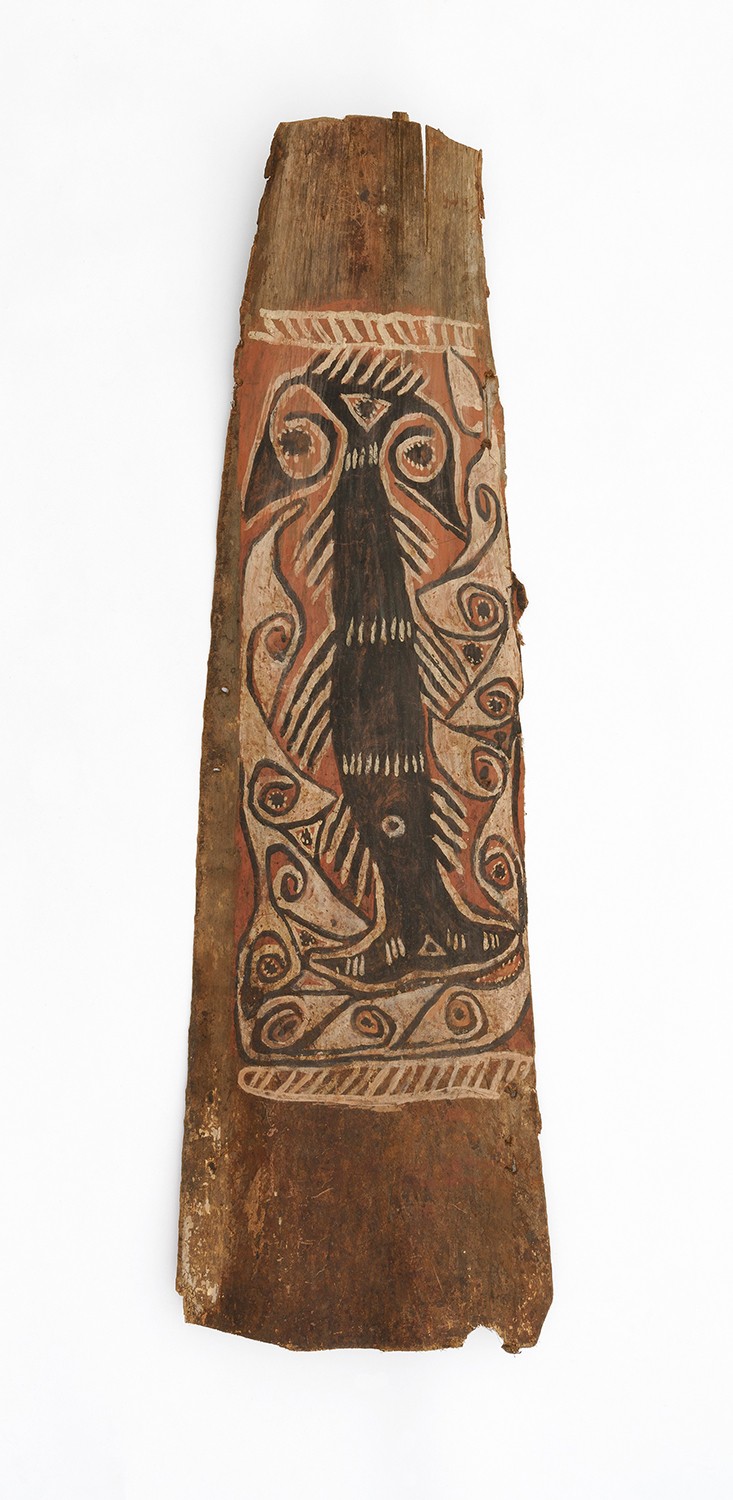 Sago palm sheath with the motif Kinin Kumnya (‘Mother of Fish’), Avim, Upper Karawari, New Guinea. Collected by Eike Haberland, Sepik Expedition, 1961. Collection Weltkulturen Museum. Photo: Wolfgang Günzel
Sago palm sheath with the motif Kinin Kumnya (‘Mother of Fish’), Avim, Upper Karawari, New Guinea. Collected by Eike Haberland, Sepik Expedition, 1961. Collection Weltkulturen Museum. Photo: Wolfgang Günzel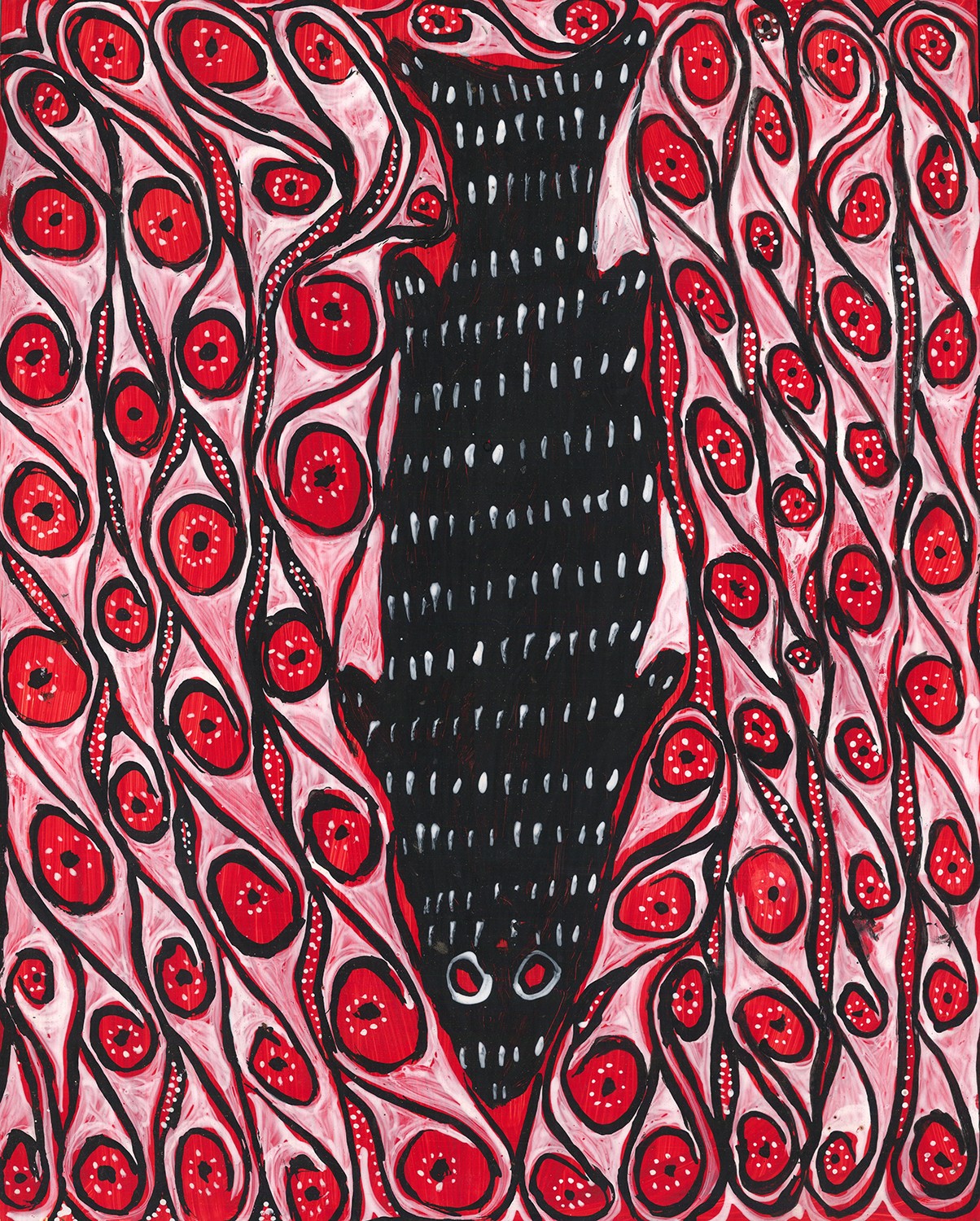 Sebastian Katuk, 2019: Kinin Kumnya I. Acrylic on paper. Avim, Upper Karawari, New Guinea. Collected by Tomi Bartole, 2019. Collection Weltkulturen Museum
Sebastian Katuk, 2019: Kinin Kumnya I. Acrylic on paper. Avim, Upper Karawari, New Guinea. Collected by Tomi Bartole, 2019. Collection Weltkulturen Museum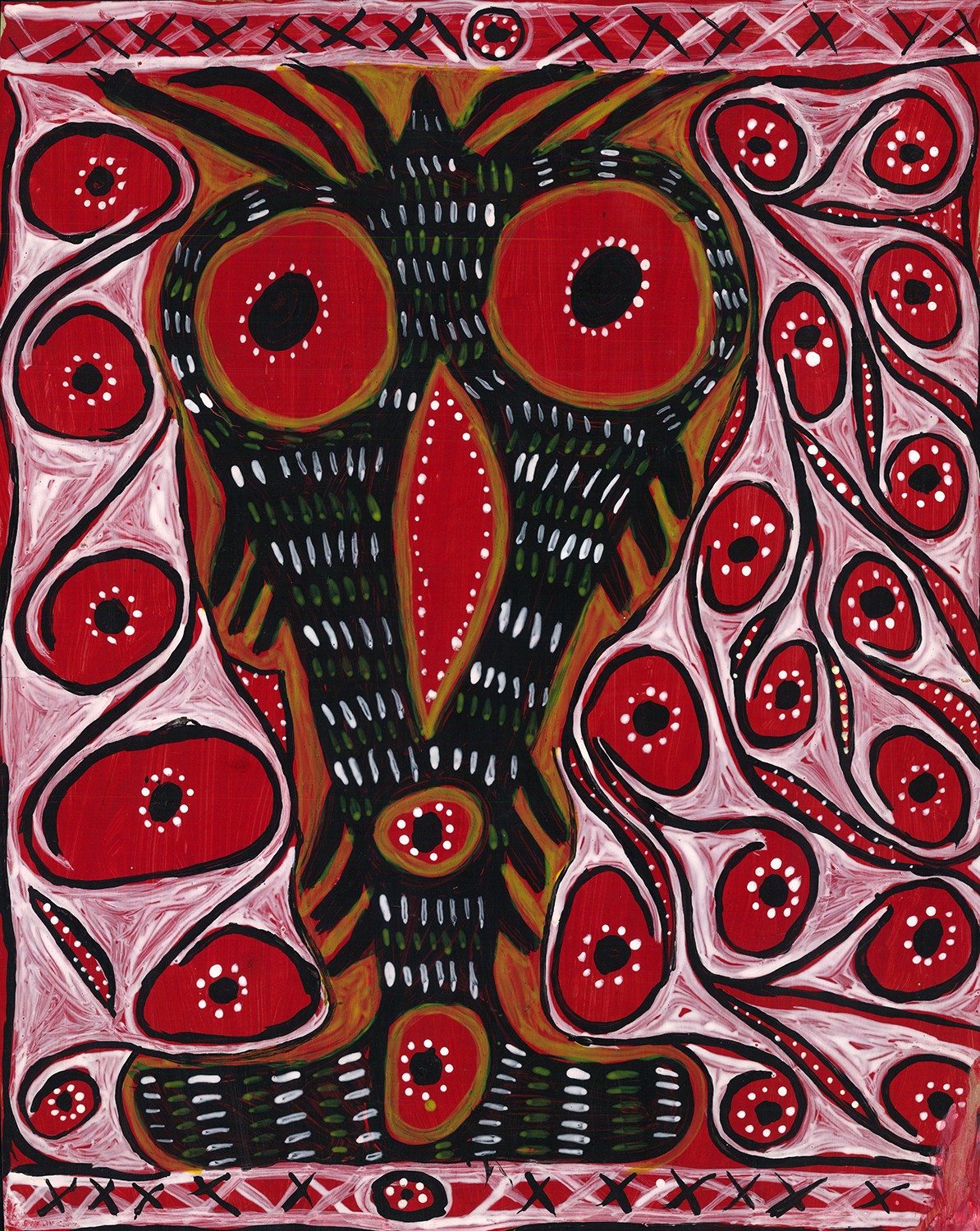 Christian Kmbsa, 2019: Kinin Kumnya 3. Acrylic on paper. Avim, Upper Karawari, New Guinea. Collected by Tomi Bartole, 2019. Collection Weltkulturen Museum
Christian Kmbsa, 2019: Kinin Kumnya 3. Acrylic on paper. Avim, Upper Karawari, New Guinea. Collected by Tomi Bartole, 2019. Collection Weltkulturen Museum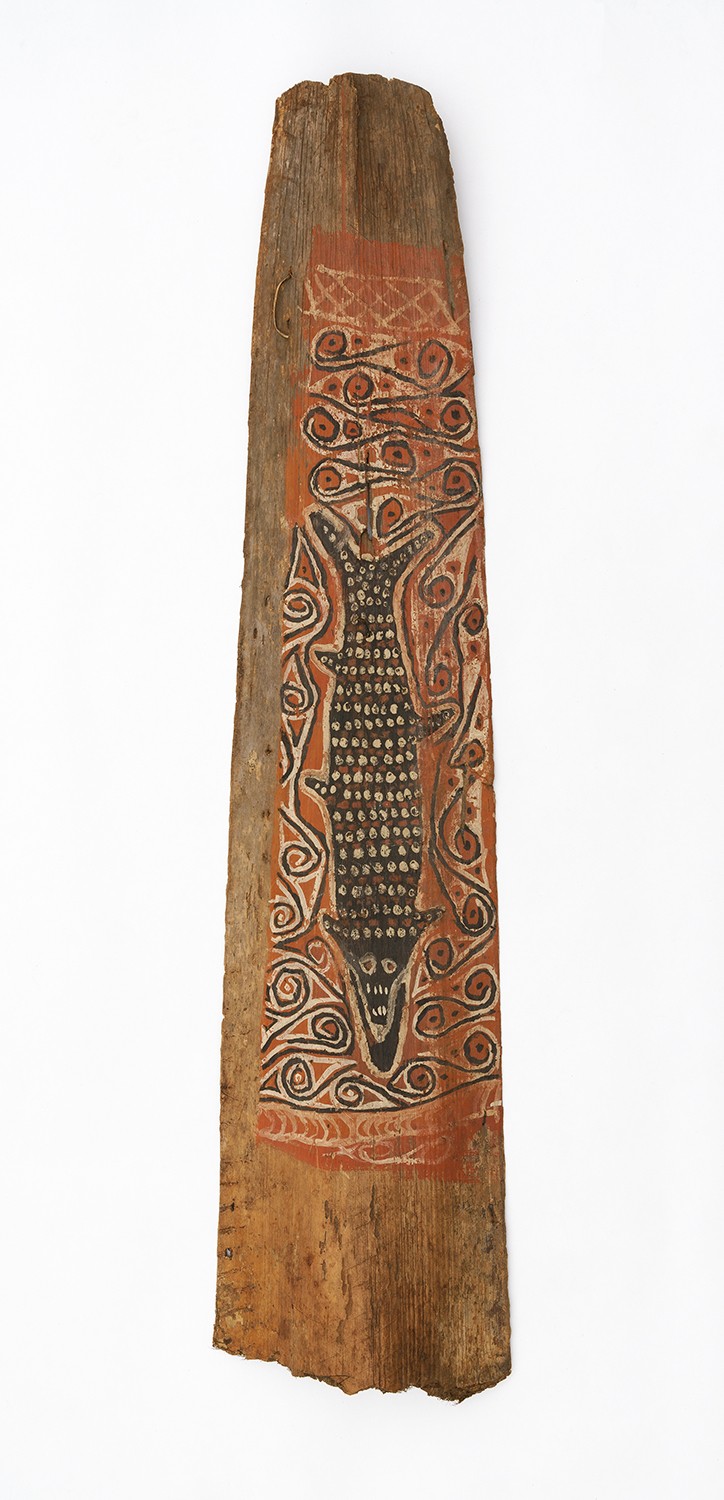 This painting is part of the wall cladding of a men’s house. The motif Kinin Kumnya (‘Mother of Fish’) was painted onto a sago palm sheath in red, black and white paint. It refers to a myth about the origin of all fi sh. Avim, Upper Karawari, New Guinea. Collected by Eike Haberland, Sepik Expedition, 1961. Collection Weltkulturen Museum. Photo: Wolfgang Günzel
This painting is part of the wall cladding of a men’s house. The motif Kinin Kumnya (‘Mother of Fish’) was painted onto a sago palm sheath in red, black and white paint. It refers to a myth about the origin of all fi sh. Avim, Upper Karawari, New Guinea. Collected by Eike Haberland, Sepik Expedition, 1961. Collection Weltkulturen Museum. Photo: Wolfgang Günzel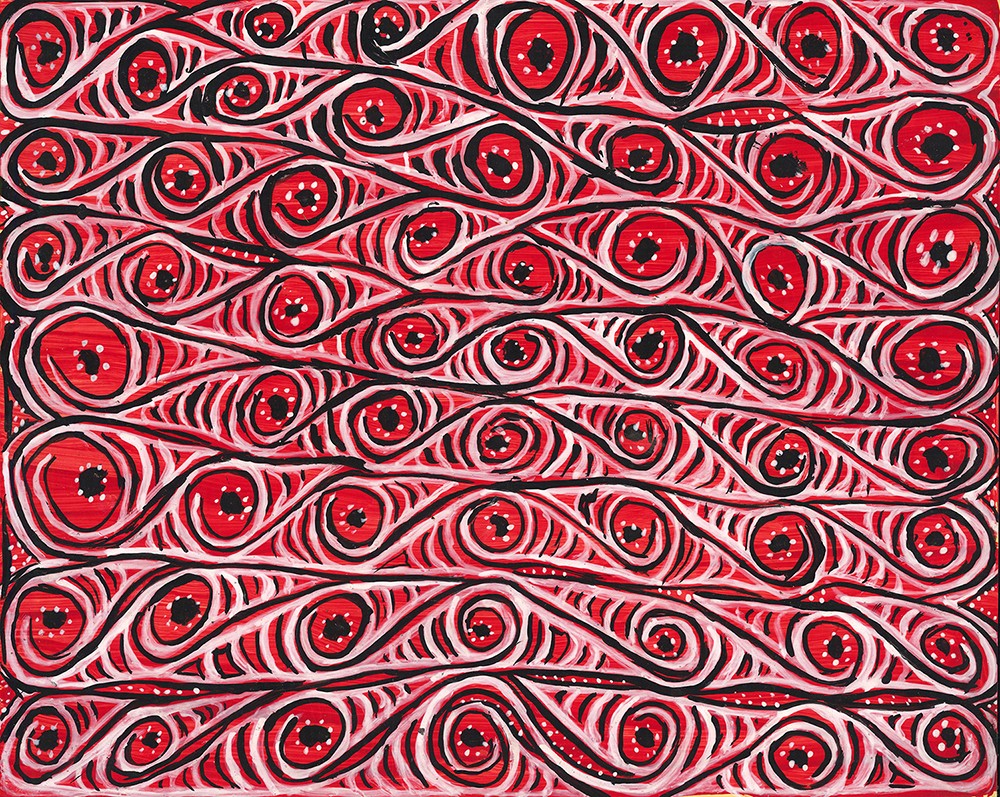 The contemporary painting from Andrias Aimo depicts Etoka Enunga, a spirit that lives in both weapons and slit drums. If this motif is applied to arrows, then they should fly further and have greater penetration power. If it is painted onto slit drums then they can be heard over long distances and are effective during hunting. Andrias Aimo, 2019: Etoka Enunga. Acrylic on paper.Avim, Upper Karawari, New Guinea. Collected by Tomi Bartole, 2019. Collection Weltkulturen Museum.
The contemporary painting from Andrias Aimo depicts Etoka Enunga, a spirit that lives in both weapons and slit drums. If this motif is applied to arrows, then they should fly further and have greater penetration power. If it is painted onto slit drums then they can be heard over long distances and are effective during hunting. Andrias Aimo, 2019: Etoka Enunga. Acrylic on paper.Avim, Upper Karawari, New Guinea. Collected by Tomi Bartole, 2019. Collection Weltkulturen Museum.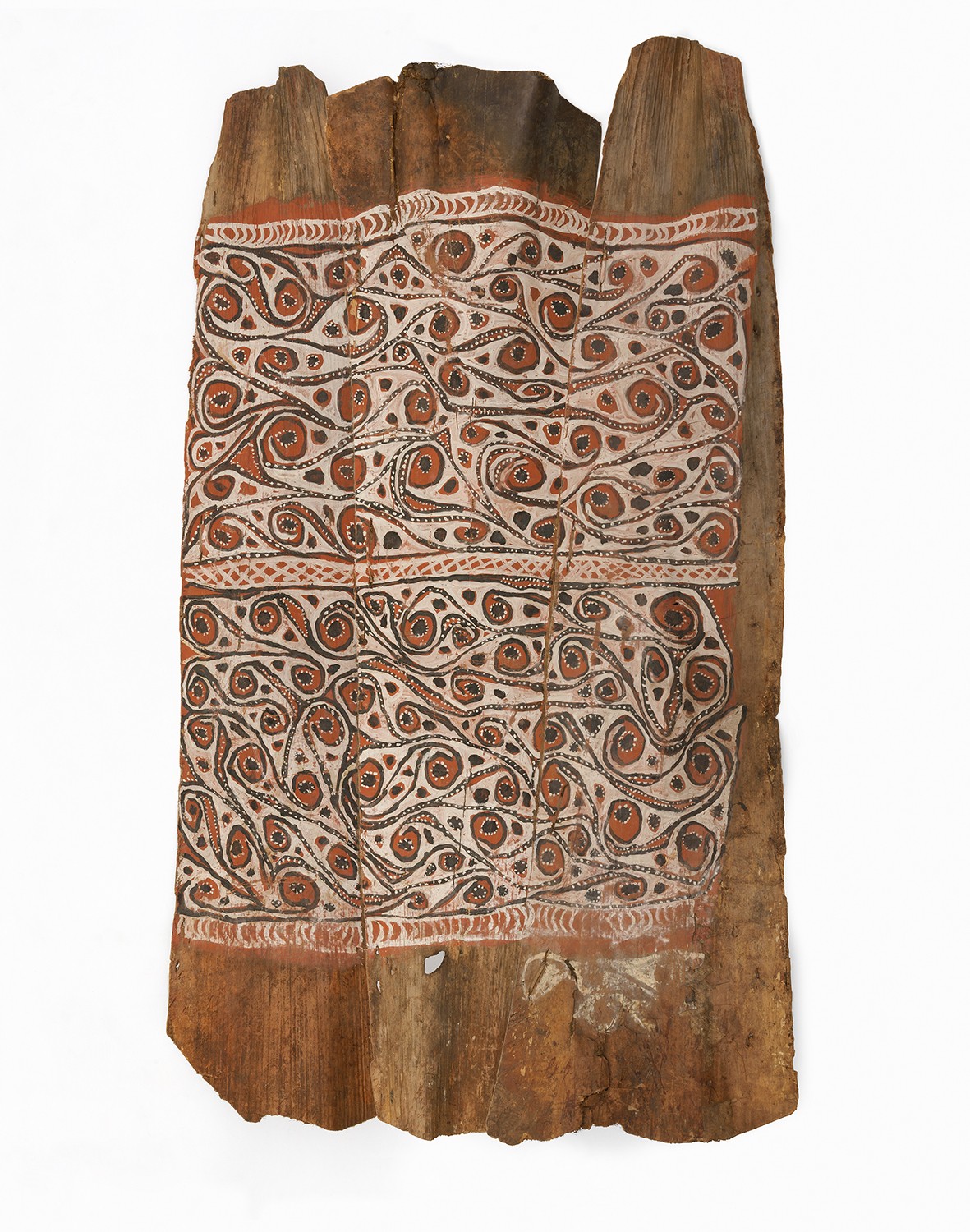 This triptych, painted on three sago palm sheaths joined together, also originates from the interior lining of the men’s house from Avim. It shows the motif Tokopai (‘Creation Pot’). In the myth the culture hero Api fi lls it with his penile blood, from out of which people and spirits arise. During the male initiation, i.e. circumcision, the blood is collected in a bowl, mixed with sago and eaten. Avim, Upper Karawari, New Guinea. Collected by Eike Haberland, Sepik Expedition, 1961. Collection Weltkulturen Museum. Photo: Wolfgang Günzel
This triptych, painted on three sago palm sheaths joined together, also originates from the interior lining of the men’s house from Avim. It shows the motif Tokopai (‘Creation Pot’). In the myth the culture hero Api fi lls it with his penile blood, from out of which people and spirits arise. During the male initiation, i.e. circumcision, the blood is collected in a bowl, mixed with sago and eaten. Avim, Upper Karawari, New Guinea. Collected by Eike Haberland, Sepik Expedition, 1961. Collection Weltkulturen Museum. Photo: Wolfgang Günzel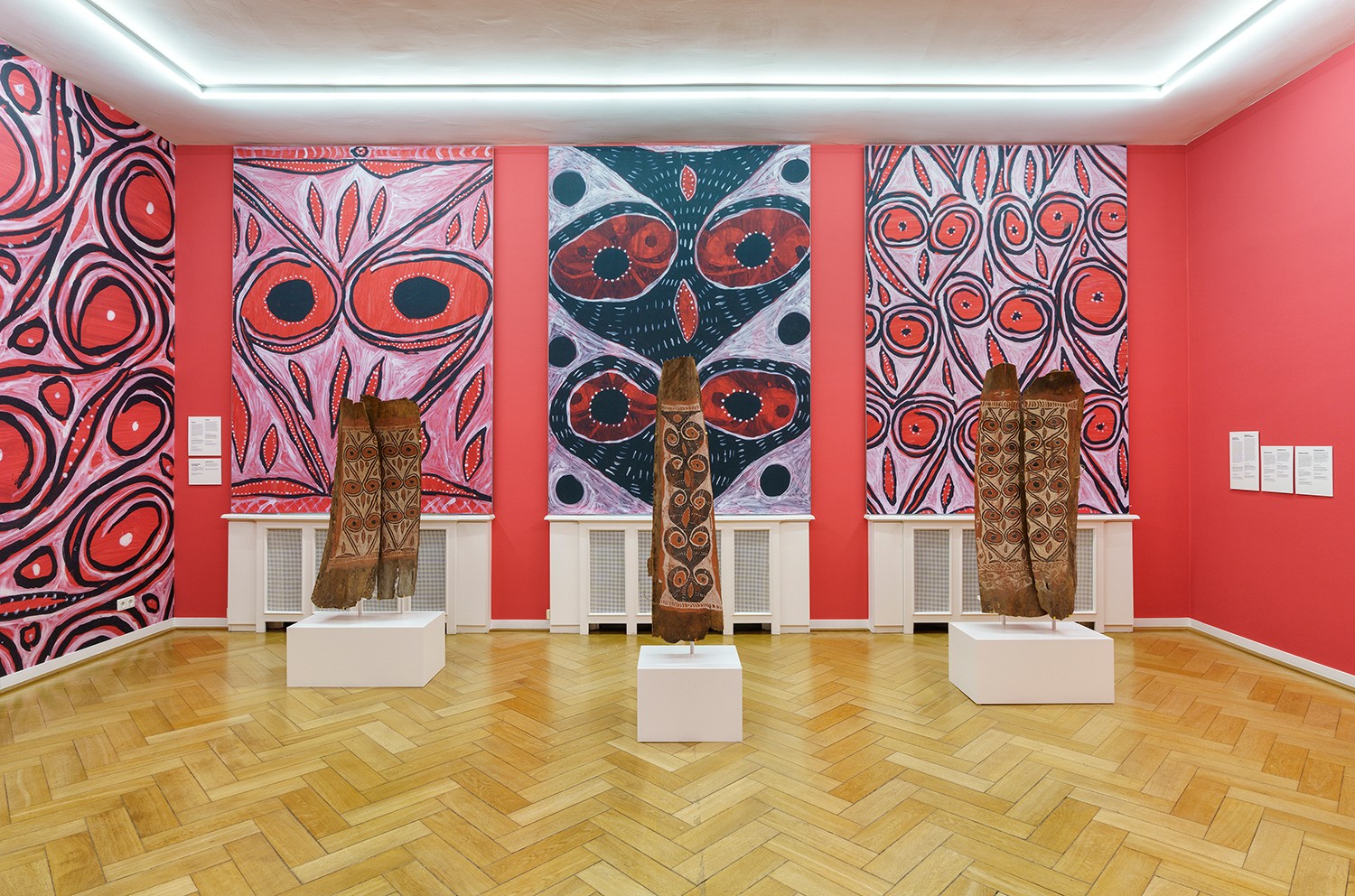 Exhibition view “Green Sky, Blue Grass. Colour Coding Words”, Weltkulturen Museum 2021, Photo: Wolfgang Günzel
Exhibition view “Green Sky, Blue Grass. Colour Coding Words”, Weltkulturen Museum 2021, Photo: Wolfgang Günzel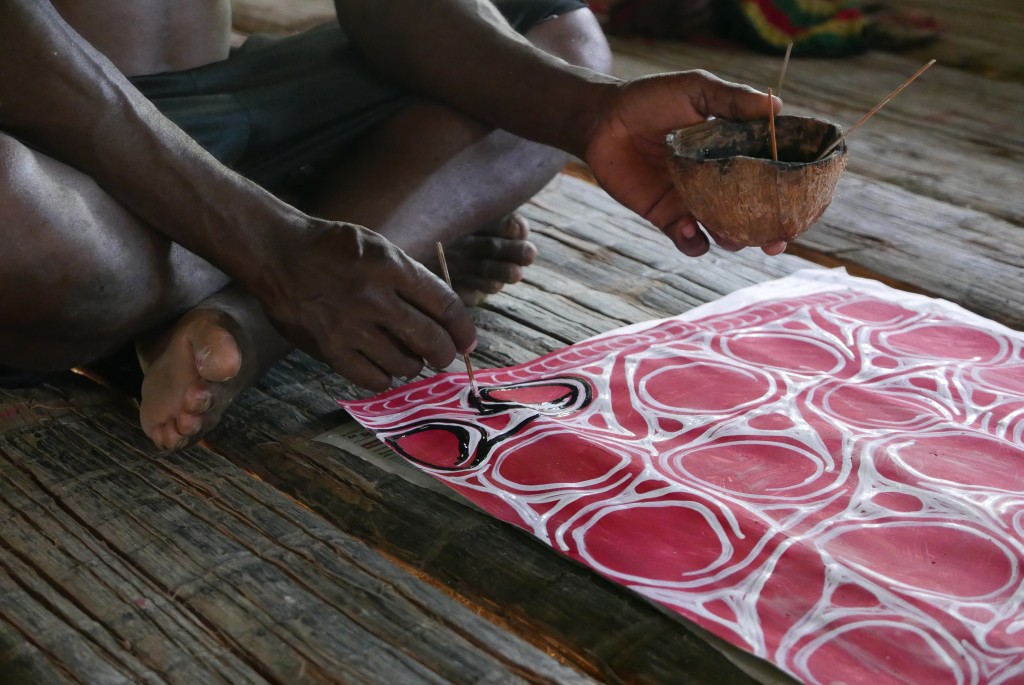 Creation of a painting. Avim, Upper Karawari, Papua New Guinea. Photo and documentation by Tomi Bartole, 2019
Creation of a painting. Avim, Upper Karawari, Papua New Guinea. Photo and documentation by Tomi Bartole, 2019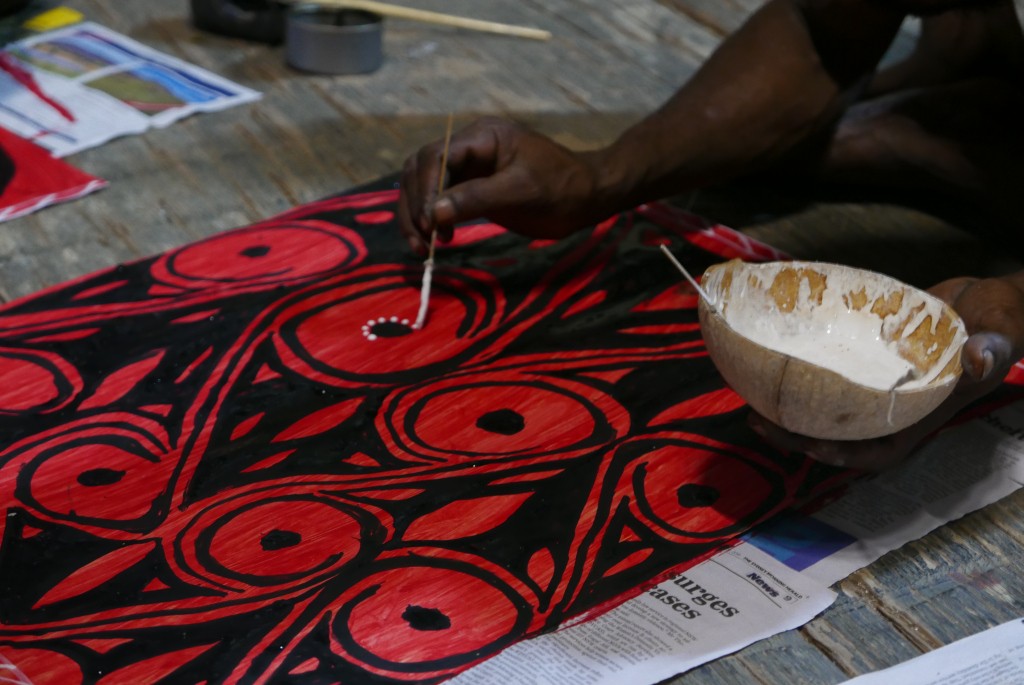 Creation of a painting. Avim, Upper Karawari, Papua New Guinea. Photo and documentation by Tomi Bartole, 2019
Creation of a painting. Avim, Upper Karawari, Papua New Guinea. Photo and documentation by Tomi Bartole, 2019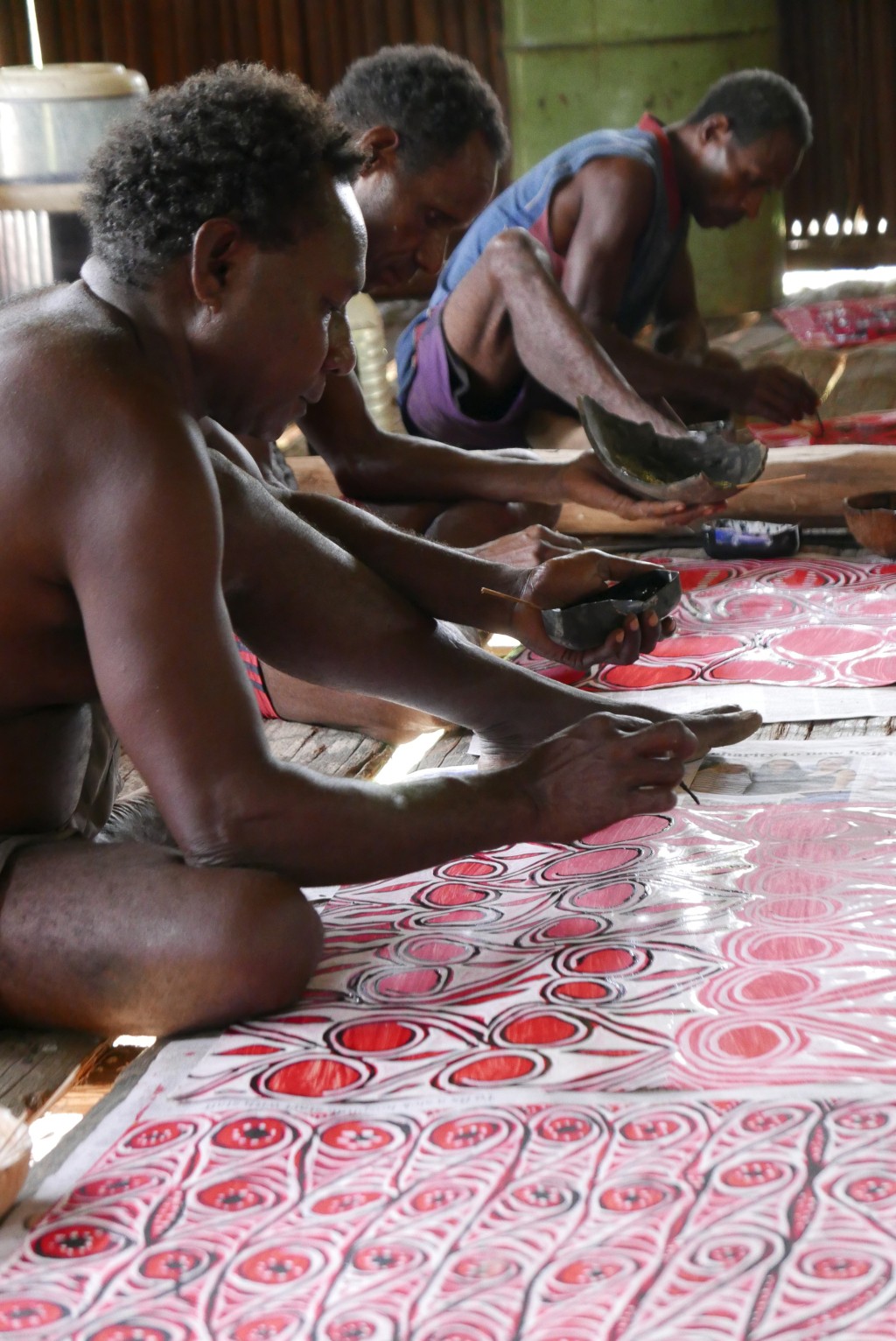 Creation of a painting. Avim, Upper Karawari, Papua New Guinea. Photo and documentation by Tomi Bartole, 2019
Creation of a painting. Avim, Upper Karawari, Papua New Guinea. Photo and documentation by Tomi Bartole, 2019
Avim paintings, Papua New Guinea
Acquisition project coordinated by Matthias Claudius Hofmann, curator for Oceania at the Weltkulturen Museum
In 2019, ethnologist Tomi Bartole travelled to Avim, a village in the East Sepik Province of Papua New Guinea. Bartole had already conducted anthropological research in Avim between 2013 and 2014, and five years later he returned there to further his research on politics and religion. On the second field trip, however, Bartole also focused on Avim art, returning to Europe with 18 paintings on paper, which he had commissioned from 11 local artists.
Many of these paintings are currently on display in the exhibition “GREEN SKY, BLUE GRASS. Colour coding worlds”, shown in conjunction with the sago palm sheath paintings that Eike Haberland collected in Avim in 1961. These paintings on sago palm sheath were used to decorate the men's house and are an impressive testimony to an art tradition outside of European art history.
But there is even more that connects the two collections: Photos of the historical paintings on sago palm sheaths found their way from Frankfurt to Avim in 2011, where they served as templates for the works that resulted in the 18 new paintings.
Another link between the two collections of paintings is Avim artist Fidelis Apot, who was involved with the painting processes both in 1961 and in 2019.
The new pictures show mythical motifs while being simultaneously viewed as actual spirits. The Avim men were following in their fathers’ footsteps when they painted these mythical motifs – but this time with acrylic paints and on paper. It is through the paintings and their potent colours that the Avim pass their sacred knowledge on to the next generation. The pictures show that despite decades of missionary work and cultural transformation, the aesthetic concepts and mythical motifs of the pre-Christian era have been preserved and are powerfully expressed in these Avim paintings. Although acrylic paints and paper have replaced the natural colours and sago palm sheaths, spirits and myths continue to live in the paintings and colours.
Names of the artists: Andrias Aimo, Vincent Apiak, Fidelis Apot, Peter Asikim, Eddie Katuk, Sebastian Katuk, Stanley Kayama, Christian Kmbsa, Conny Tapain, Nelson Tatambi, Justine Waipo
Interview with Tomi Bartole in the Weltkulturen News.
Learn more about the acquisition project.

